(© Gautier Houba)
Romantic scenes by the lake, picturesque landscapes, or charming family gatherings... None of those are to be found at the Maison des Cultures in Saint-Gilles, where, until Sunday, you can visit the exhibition the KutiKuti crew developed for Cultures Maison.
The fourth edition of the festival for independent, small-press comics and publications invited six members of the Finnish underground collective and magazine publisher as guests of honour, resulting in a spectacular show. On the spot, Benjamin Bergman, Heta Bilaletdin, Roope Eronen, Jarno Latva-Nikkola, Sami Aho, and Tommi Musturi built a cardboard monster playing a terrifying organ that fills the whole room with resounding products of their imagination. Filth, fury, rebellion, and humour are all part of the incredibly diverse, intense, and colourful KutiKuti universe. We sat down with Finland’s finest for a short chat!
There are six of you here. But the whole KutiKuti crew is bigger, isn’t it?
Tommi: Yeah, the collective consists of about fifteen people. But it’s changing all the time. When we started out in 2005, there were six of us. Five of those original members are still part of the crew.
KutiKuti: Finland's finest at Cultures Maison
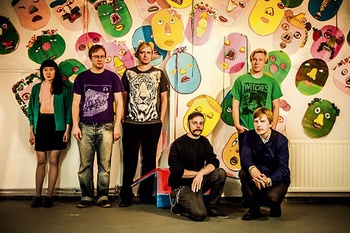
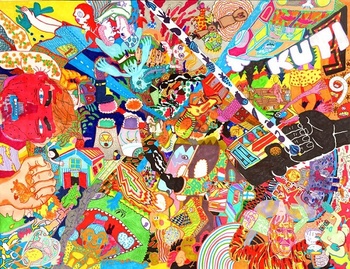
(cover Kuti 9)
How did the collective come about?
Tommi: We started out as a studio, in fact. We all used to work on our stuff at home, but when other people from the collective started moving to Helsinki as well, we took up residency in a studio there. We still have it, but not all of us are as studio-orientated as we used to be. It was something among friends. Well, we still are friends, I suppose. (Laugh) And within a year also the newspaper came into being.
Kuti was voted “Best Finnish Cultural Publication” a couple of years ago. To make it completely free is quite an original idea.
Roope: It was taken straight from Paper Rodeo from Providence in the United States. So it’s very much a stolen idea. (Laughter)
Tommi: In Finland you can’t find our books in many bookstores, so we thought we’d make a free publication and just hand it out. To educate the audience. (Laughs) We have our subscribers and next to that, it’s distributed in 300 places in ten cities in Finland.
Benjamin: We do it because publishing is fun!
Roope: It’s also nice to get your hands on your comic right away. If you make a book, you have to wait along time. Kuti only takes two days to print.
How did the collective come about?
Tommi: We started out as a studio, in fact. We all used to work on our stuff at home, but when other people from the collective started moving to Helsinki as well, we took up residency in a studio there. We still have it, but not all of us are as studio-orientated as we used to be. It was something among friends. Well, we still are friends, I suppose. (Laugh) And within a year also the newspaper came into being.
Kuti was voted “Best Finnish Cultural Publication” a couple of years ago. To make it completely free is quite an original idea.
Roope: It was taken straight from Paper Rodeo from Providence in the United States. So it’s very much a stolen idea. (Laughter)
Tommi: In Finland you can’t find our books in many bookstores, so we thought we’d make a free publication and just hand it out. To educate the audience. (Laughs) We have our subscribers and next to that, it’s distributed in 300 places in ten cities in Finland.
Benjamin: We do it because publishing is fun!
Roope: It’s also nice to get your hands on your comic right away. If you make a book, you have to wait along time. Kuti only takes two days to print.
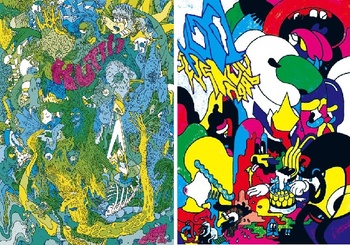
(covers Kuti 17 & 1)
Do you consider it to be a laboratory?
Tommi: Yeah, I think everybody uses it to try out new stuff.
Benjamin: I’d say it was an opportunity that wasn’t there before. Of course, you also have web comics these days, where people can do whatever they like. But I guess, a lot of artists still like the print medium. And maybe it inspires readers, people who are already drawing, to try something different. Or people who aren’t publishing yet, to try to get their work published. I remember that when I wanted to do comics as a teenager, there was an almost unbridgeable gap between you drawing at home and the people who were already being published. This paper kind of tightens that gap, lowers the threshold. Which is good, people should aspire for more, and try to get better at what they do.
Tommi: We once did one edition for the Swedish market. We selected Swedish artists who were completely unknown. In Sweden there is even a bigger gap to cross, the underground scene is even smaller. But we made a really good selection, and two years later, those same people were making books, though at that time, the majority of the Swedish audience saw their work for the first time. So it can really mean something on that level.
Are there other examples of people publishing in Kuti that went through to regular publishers?
Roope: I especially remember the time those regular publishers hated everything in Kuti. They thought we were ruining the entire comics scene. We were bad for comics!
Sami: Especially in Finland the reactions are really negative. (Laughter)
Do you consider it to be a laboratory?
Tommi: Yeah, I think everybody uses it to try out new stuff.
Benjamin: I’d say it was an opportunity that wasn’t there before. Of course, you also have web comics these days, where people can do whatever they like. But I guess, a lot of artists still like the print medium. And maybe it inspires readers, people who are already drawing, to try something different. Or people who aren’t publishing yet, to try to get their work published. I remember that when I wanted to do comics as a teenager, there was an almost unbridgeable gap between you drawing at home and the people who were already being published. This paper kind of tightens that gap, lowers the threshold. Which is good, people should aspire for more, and try to get better at what they do.
Tommi: We once did one edition for the Swedish market. We selected Swedish artists who were completely unknown. In Sweden there is even a bigger gap to cross, the underground scene is even smaller. But we made a really good selection, and two years later, those same people were making books, though at that time, the majority of the Swedish audience saw their work for the first time. So it can really mean something on that level.
Are there other examples of people publishing in Kuti that went through to regular publishers?
Roope: I especially remember the time those regular publishers hated everything in Kuti. They thought we were ruining the entire comics scene. We were bad for comics!
Sami: Especially in Finland the reactions are really negative. (Laughter)
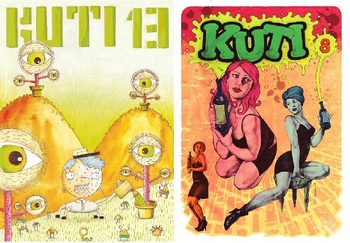
(covers Kuti 13 & 8)
From the publishing houses?
Tommi: No, most people. It’s just too much for them. Well, we only hear the people that complain, the people who like it, don’t say anything. They just sit at home and read the paper.
Sami: But there has been a big change in comics these last ten, fifteen years. In the way to tell stories. So there’s another kind of readership as well.
Tommi: I don’t think we make our paper just for the comics scene. I think our audience is broader than that, it’s an open-minded cultural scene.
You often launch an open call for contributions. Do you get a lot of stuff sent to you?
Tommi: We get around 100 pages sent to us per issue. Since our issues only have 16 pages, we can’t even publish the majority.
Benjamin: It’s funny, this paper was meant to be there for beginning comics artists, because it is so hard to get published by a big publisher. But I think in the meantime it has become equally hard to get published in Kuti if you’re a teenager.
Tommi: But there are two to three new artists featured in every paper. It’s a good average.
From the publishing houses?
Tommi: No, most people. It’s just too much for them. Well, we only hear the people that complain, the people who like it, don’t say anything. They just sit at home and read the paper.
Sami: But there has been a big change in comics these last ten, fifteen years. In the way to tell stories. So there’s another kind of readership as well.
Tommi: I don’t think we make our paper just for the comics scene. I think our audience is broader than that, it’s an open-minded cultural scene.
You often launch an open call for contributions. Do you get a lot of stuff sent to you?
Tommi: We get around 100 pages sent to us per issue. Since our issues only have 16 pages, we can’t even publish the majority.
Benjamin: It’s funny, this paper was meant to be there for beginning comics artists, because it is so hard to get published by a big publisher. But I think in the meantime it has become equally hard to get published in Kuti if you’re a teenager.
Tommi: But there are two to three new artists featured in every paper. It’s a good average.
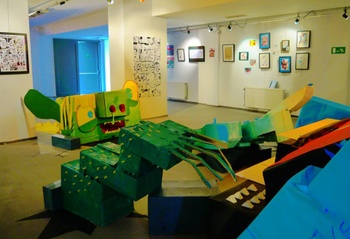
(© Suky Deprez)
You make Kuti in complete liberty. Does it make you more experimental?
Roope: It should. (Laughter) But we’re always in such a hurry to make that awesome paper.
Tommi: I don’t think we’re only focused on publishing experimental stuff. We publish traditional comics as well. There is something good in everything. But it happens quite often that when we ask artists with a more traditional approach to make us something, they end up doing something completely experimental. And then we’re all “Why didn’t you just do your regular stuff?” (Laughter)
Roope: It’s a good publication to experiment.
Tommi: And none of us studied comics. There wasn’t a school where you could learn that stuff in Finland. So, KutiKuti functioned as some sort of a school, as a sounding board.
Did you ever do collective comics.
Sami: Yeah, in the first issues we did a few collaborations. And the cardboard installations at exhibitions like this one.
Tommi: We do about two or three exhibitions a year. Besides our personal ones. We started painting together, and trying to make the individual work disappear, to present it as a collective work. But yeah, it’s also really good for my own development as an artist.
You make Kuti in complete liberty. Does it make you more experimental?
Roope: It should. (Laughter) But we’re always in such a hurry to make that awesome paper.
Tommi: I don’t think we’re only focused on publishing experimental stuff. We publish traditional comics as well. There is something good in everything. But it happens quite often that when we ask artists with a more traditional approach to make us something, they end up doing something completely experimental. And then we’re all “Why didn’t you just do your regular stuff?” (Laughter)
Roope: It’s a good publication to experiment.
Tommi: And none of us studied comics. There wasn’t a school where you could learn that stuff in Finland. So, KutiKuti functioned as some sort of a school, as a sounding board.
Did you ever do collective comics.
Sami: Yeah, in the first issues we did a few collaborations. And the cardboard installations at exhibitions like this one.
Tommi: We do about two or three exhibitions a year. Besides our personal ones. We started painting together, and trying to make the individual work disappear, to present it as a collective work. But yeah, it’s also really good for my own development as an artist.
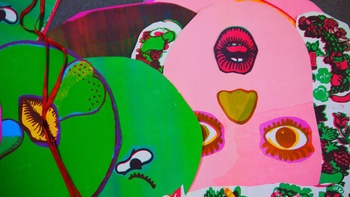
(© Suky Deprez)
At the exhibition here at Cultures Maison, the individual names have been left out as well.
Tommi: There are just too many works.
Roope: And it’s not that important.
Spoken as a real collective!
Roope: Yeah, that’s how we explain it. (Laughter)
Sami: In the first issues of Kuti, there were no names at all. For the same reason.
Tommi: But then lots of people complained. “It’s unbelievable you didn’t put any names in there."
Benjamin: It’s understandable: they wanted to know who the particular artists were.
Tommi: So they would know whose work they hated, and whose they liked.
So you ended up getting a lot of questions for the name of the guy who did page 7, but the one who did page 3, nah, not so much...
Tommi: We didn’t even have page numbers. (Laughter)
Benjamin: But again, it’s understandable. When these artists have their own publications, our readers would want to know so they can buy them at the bookstore.
Roope: But the bookstore doesn’t have our books. (Laughter)
At the exhibition here at Cultures Maison, the individual names have been left out as well.
Tommi: There are just too many works.
Roope: And it’s not that important.
Spoken as a real collective!
Roope: Yeah, that’s how we explain it. (Laughter)
Sami: In the first issues of Kuti, there were no names at all. For the same reason.
Tommi: But then lots of people complained. “It’s unbelievable you didn’t put any names in there."
Benjamin: It’s understandable: they wanted to know who the particular artists were.
Tommi: So they would know whose work they hated, and whose they liked.
So you ended up getting a lot of questions for the name of the guy who did page 7, but the one who did page 3, nah, not so much...
Tommi: We didn’t even have page numbers. (Laughter)
Benjamin: But again, it’s understandable. When these artists have their own publications, our readers would want to know so they can buy them at the bookstore.
Roope: But the bookstore doesn’t have our books. (Laughter)
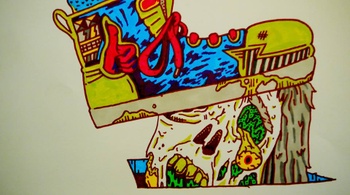
(© Suky Deprez)
Is the editorial work also a collective responsibility?
Roope: It used to be, but now it’s a dictatorship.
Heta: Though the dictator changes nowadays.
Sami: Yeah, Tommi has been doing a bit too much work lately.
Kuti features a lot of international comics artists (amongst many others also Belgians Kama & Seele and Brecht Vandenbroucke). Do you also have a large international audience?
Tommi: In the 29 issues we published since 2006, there were about 200 artists. Our subscribers come from fifteen countries.
Roope: We’ve got one reader in Japan, one in New Zealand...
Benjamin: And wasn’t there this one guy from Peru as well? (Laughter)
A subscription to Kuti (four issues a year) costs €15. More info: www.kutikuti.com
Last chance to visit: Sunday from 1.30 to 4.30 pm, Maison des Cultures, rue de Belgrade 120, Saint-Gilles!!
Is the editorial work also a collective responsibility?
Roope: It used to be, but now it’s a dictatorship.
Heta: Though the dictator changes nowadays.
Sami: Yeah, Tommi has been doing a bit too much work lately.
Kuti features a lot of international comics artists (amongst many others also Belgians Kama & Seele and Brecht Vandenbroucke). Do you also have a large international audience?
Tommi: In the 29 issues we published since 2006, there were about 200 artists. Our subscribers come from fifteen countries.
Roope: We’ve got one reader in Japan, one in New Zealand...
Benjamin: And wasn’t there this one guy from Peru as well? (Laughter)
A subscription to Kuti (four issues a year) costs €15. More info: www.kutikuti.com
Last chance to visit: Sunday from 1.30 to 4.30 pm, Maison des Cultures, rue de Belgrade 120, Saint-Gilles!!
Read more about: Expo, Events & Festivals
Fijn dat je wil reageren. Wie reageert, gaat akkoord met onze huisregels. Hoe reageren via Disqus? Een woordje uitleg.